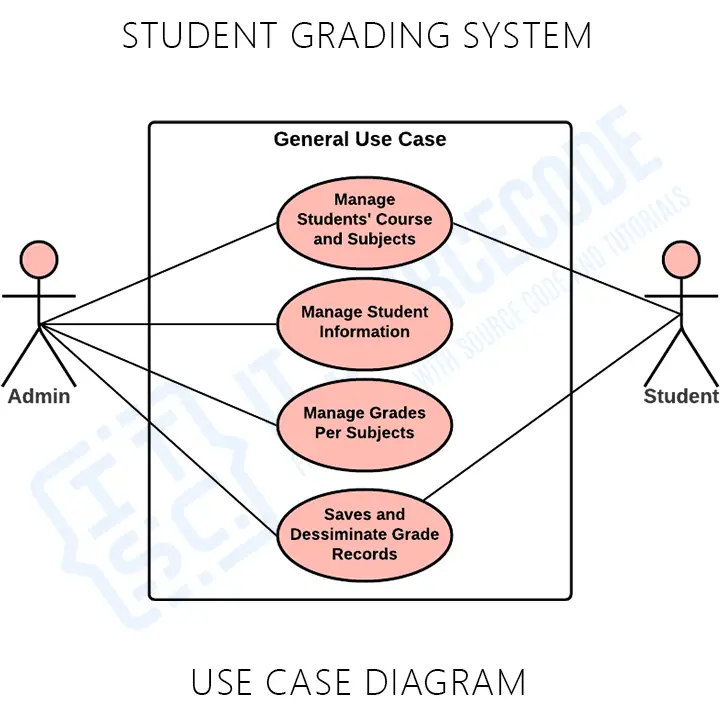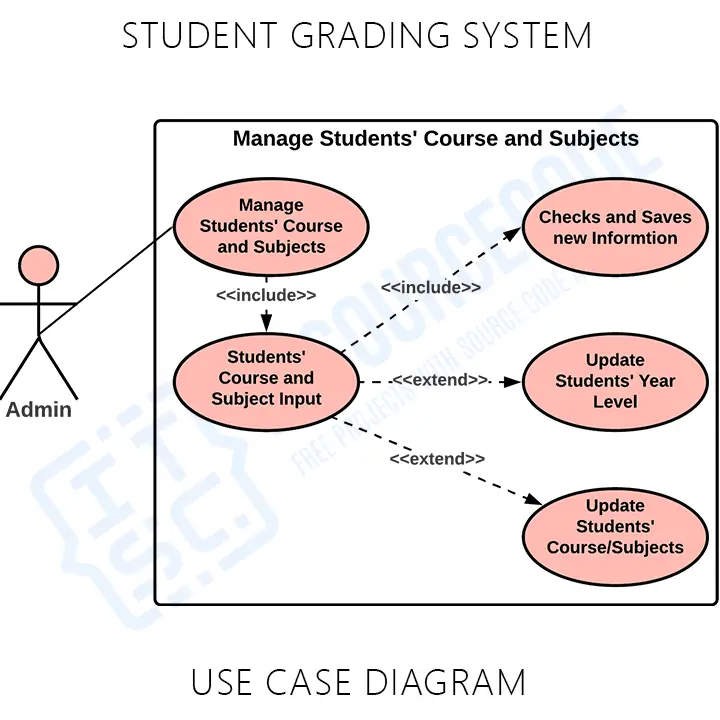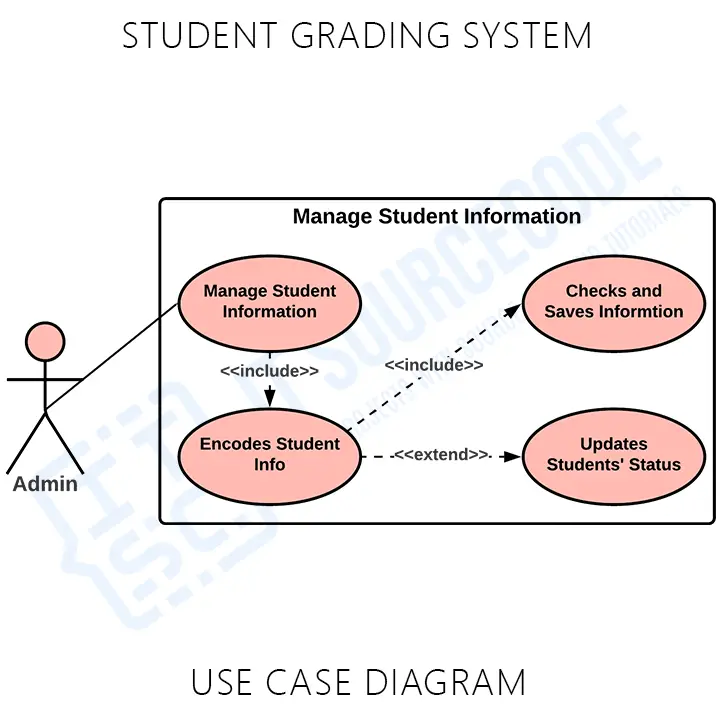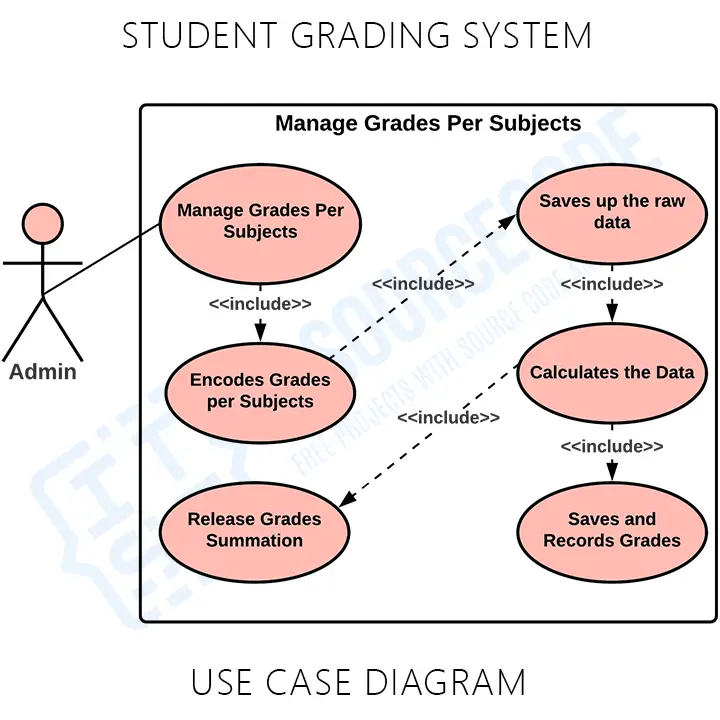The UML use case diagram is a method use to show the processes involved in student grading system. It depicts the system’s supposed structure and behavior.
Additionally, the diagram consists of processes (use cases) and users or “actors”. It uses defined symbols to describe the overall flow of the system.
Project Overview
| Name: | Student Grading System Use Case Diagram |
| Users: | Subject Teachers (Instructors), School Registrar, and Students. |
| Tools Used: | Any Diagram tools that provide use case diagram symbols. |
| Designer: | ITSourceCode.com |
What is a Use Case Diagram
The use case diagram for student grading system shows the sample behavior of the software. It includes the project functions using use cases, actors, and their connections.
Moreover, the diagram assists you to define and organize project needs. This also provides a clear picture of the user and system relationships. Therefore, this diagram depicts the complex function of a system including how the user reacts to it.
Importance of UML Use Case Diagram
Helping the developers and businesses with system development is one of the importance of the UML use case diagram. It includes the procedures from the viewpoint of users.
Furthermore, the diagram serves as the system analysis to identify, clarify, and organize the project needs. This diagram works best with other UML Diagrams for Student Grading System. Other UML diagrams include activity, class, sequence, deployment, and component diagrams.
Use Case Diagram for Student Grading System
The use case diagram example for student grading system has two main illustrations. These illustrations describe the system’s general and specific processes.

The general use case is the most common application of a use case diagram. It conveys the system’s main components as well as the flow of information between them.
Use Case Diagram using Include and Extend
The use case diagram using include and extend is used to elaborate the proceeding diagrams.
The label “include” clarifies that the sub-processes were needed to complete the task. Extend, on the other hand, declares that the sub-processes can only be performed when needed.
Monitor and Manage Student Courses and Subjects Use Case Diagram
The scenario shown explains how the admin control the courses’ information and their pre-requisite subjects. They were saved into the system as basis for calculation of students’ outputs. It will also monitor and validate the saved information.

Manage Student Information Use Case Diagram
This process allows the admin to manage student’s status, year level, as well as their course and subjects taken. These were the basis for collecting, calculating and summation of their grades.

Manage Student’s Information Use Case Diagram
This explains how the users handle data from teachers to students in each subject. The teachers don’t have to manually manage the student’s grades but only encode them into the system and then the system will do the rest.

You can add more to this illustration and it is up to you how will you create your diagram. But make sure to have precise information and consider the included use cases.
Use Case Diagram for Student Grading System Pdf
How to draw a Use Case Diagram?
Time needed: 2 minutes
Here’s the complete guide on how to draw a student grading system use case diagram.
- Step 1: Familiarize Use Case Diagram Symbols
For beginners, you need to familiarize first with use case symbols to be used.
- Step 2: Determine the system processes
The next step is to determine the system’s processes. They will be the use cases of your project.
You may ask the users about the typical activities done in student grade management. - Step 3: Analyze the use cases included
The gathered information from the users needs to be evaluated to know the general use cases.
From the general use cases, you will see the sub-cases that are included. But, only include the useful processes related to the student grading system. - Step 4: Plot the Use Case Diagram
To plot the diagram you will need the users, use cases, container (scope), and their indicators (association). You will base the flow of use cases on the evaluated information from the users.
Your first move is to place the users involved.
Next, put the container in the plotted diagram to separate the objects (users and system) scope.
Then place the use cases of the grade management.
Finally, you need to map out the association of the use cases to show the interactions between the user/s and the system.
Conclusion:
The UML use case diagram represents the methodology used in system development. It helps developers know the possible inputs that the project should process and perform.
Furthermore, you will discover the needed processes and connect them to the other UML Diagrams. The diagram is also applicable in modeling the software’s use cases (processes). It captures the system’s flow from one process to the next.
Related Articles:
Inquiries
If you have concerns about the Student Grading System Use Case Diagram, leave us your comments below.

